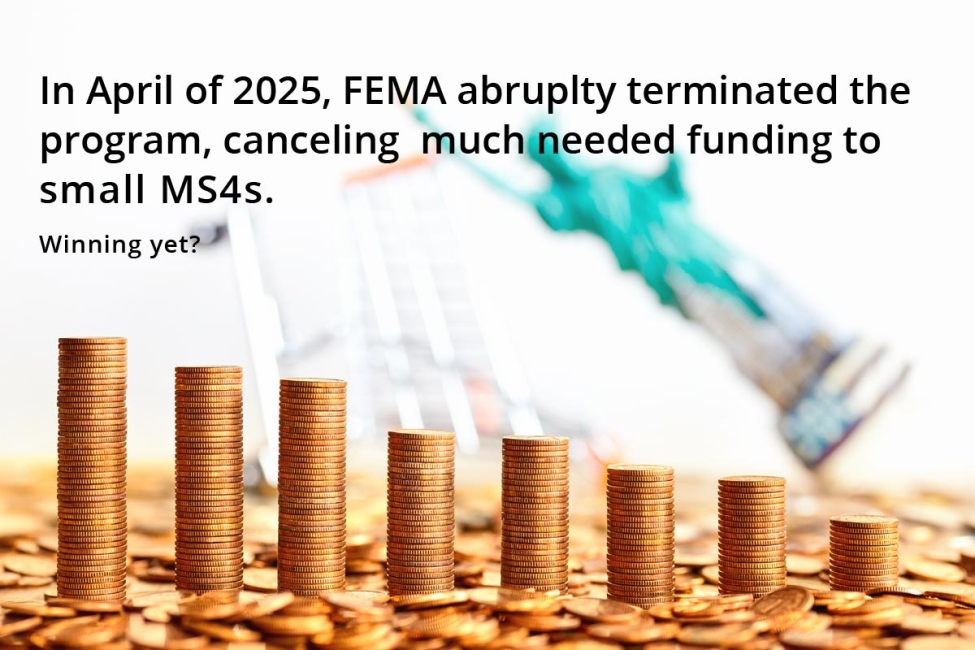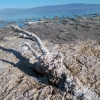
For almost five years the Building Resilient Infrastructure and Communities (BRIC) grant program served as FEMA’s flagship source of hazard-mitigation funding. It directed a steady slice of federal disaster-relief dollars toward projects that would lower future losses, and many small Municipal Separate Storm Sewer System (MS4) operators saw it as a rare chance to finance culvert upsizing, green-street retrofits, stormwater detention upgrades, and other resilience measures that rarely fit into tight local budgets. FEMA framed BRIC as a vehicle for “pre-disaster” investment, encouraging communities to shift from reaction to prevention (FEMA).
Why BRIC Mattered to Small MS4s
Small MS4 jurisdictions often juggle Clean Water Act obligations with aging infrastructure and limited revenue. BRIC’s 75 percent federal match, and the possibility of a 90 percent share for Economically Disadvantaged Rural Communities, dramatically lowered the fiscal hurdle for towns of just a few thousand residents (US EPA). The program also awarded up to forty technical-evaluation points when a project benefited an ED rural community or a new Community Disaster Resilience Zone, giving small towns a competitive leg up in national scoring (FEMA).
Basic Eligibility, Now Historical, but Still Informative
To qualify, sub-applicants needed a FEMA-approved Hazard Mitigation Plan, a benefit-cost ratio of at least 1.0 (unless the community met certain disadvantaged thresholds), and designs that complied with the latest consensus-based building codes. The FY 2024 Notice of Funding Opportunity opened on 6 January 2024, with applications due in the FEMA GO portal by 18 April 2025, reinforcing FEMA’s message that quality proposals require long lead times (ICF). Although those deadlines ultimately became moot, the documentation that towns assembled, hydraulic models, lifecycle cost analyses, and public-engagement records, remains useful for other funding streams.
Typical BRIC-Eligible Stormwater Projects
Before its cancellation, BRIC routinely funded bridge and culvert replacements sized for future rainfall, retrofits that diverted first-flush runoff into bioretention cells, pump-station hardening, and the digitization of drainage inventories that underpin MS4 mapping requirements. These investments resonated with the MS4 “minimum control measures,” improving flood control, water quality, and regulatory compliance in one stroke.
The April 2025 Termination
On 4 April 2025 FEMA abruptly announced that it was ending the BRIC program, canceling the $750 million FY 2024 competition and returning unobligated funds from every award year back to the Disaster Relief Fund or the Treasury (ICC). An advisory issued on 16 April clarified that projects already under construction could finish, but anything not yet obligated would be closed out, and no new applications would be reviewed . FEMA stated that it is “developing a new approach to mitigation that is more responsive to state and local requirements,” though no replacement program has been released as of mid-July 2025 (ASFPM).
What the Shutdown Means for Small MS4s
The end of BRIC does not erase the underlying need for flood-resilient stormwater infrastructure, nor does it negate the preparatory work many towns completed. Instead, small MS4 operators should pivot that material toward:
• The Hazard Mitigation Grant Program (HMGP) and Flood Mitigation Assistance (FMA), both of which continue to operate and accept similar project types.
• State revolving-fund loans, especially those that now offer principal forgiveness for green-infrastructure elements.
• Congressionally Directed Spending requests, which often cite prior FEMA benefit-cost analyses as evidence of merit.
• Emerging Community Disaster Resilience Zone grants once FEMA finalizes guidance under the 2022 Disaster Recovery Reform Act amendments.
Staying Ready for Whatever Comes Next
Even without BRIC, FEMA’s scoring philosophy offers a roadmap. Maintain an up-to-date, multi-jurisdictional Hazard Mitigation Plan that clearly links stormwater shortcomings to flood risk. Keep benefit-cost calculations current, using the latest precipitation frequency curves and construction estimates. Document how each project supports the MS4 program, reduced sediment loading, better outfall stability, lower emergency-maintenance costs, so that any future federal or state solicitation can be answered quickly.
BRIC’s cancellation is a setback for small MS4s that rely on external capital, yet the program’s legacy is a stronger pipeline of shovel-ready projects and a deeper understanding of resilience accounting. By preserving that groundwork and watching for the next iteration of federal mitigation funding, stormwater managers can stay in position to capture the resources they need to protect their communities from the next record-breaking storm.
 Wetlands are often described as the kidneys of the watershed because they filter, slow, and transform the water that passes through them in ways that …
Wetlands are often described as the kidneys of the watershed because they filter, slow, and transform the water that passes through them in ways that …
 Field inspections of catch basins, manholes, culverts, and outfalls form the foundation of responsible stormwater management. These routine checks giv…
Field inspections of catch basins, manholes, culverts, and outfalls form the foundation of responsible stormwater management. These routine checks giv…
 Habitat disruption around drainage structures is often subtle at first, and many of the earliest signs tend to appear during ordinary field work rathe…
Habitat disruption around drainage structures is often subtle at first, and many of the earliest signs tend to appear during ordinary field work rathe…
 Harmful algal blooms have become one of the most pressing water quality problems in many regions, and their rise has been linked to a complicated blen…
Harmful algal blooms have become one of the most pressing water quality problems in many regions, and their rise has been linked to a complicated blen…
 The Salton Sea is one of California’s most unusual and tragic landscapes, a place shaped by accident, transformed by ambition, and ultimately pu…
The Salton Sea is one of California’s most unusual and tragic landscapes, a place shaped by accident, transformed by ambition, and ultimately pu…
 *The screenshots used in this article are from Roadwurx, an asset management software created for road maintenance departments. Managing a town’…
*The screenshots used in this article are from Roadwurx, an asset management software created for road maintenance departments. Managing a town’…